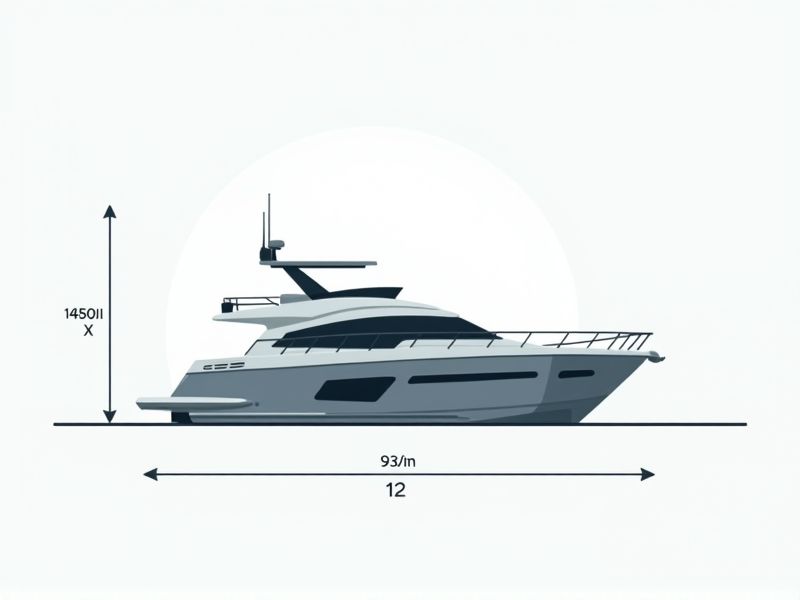
Yachts come in a wide range of sizes, but standard dimensions can help you narrow down your search or assess what fits your needs. Most commonly, yachts range from 30 to 150 feet (about 9 to 45 meters) in length, with a beam (width) typically between 10 and 30 feet (3 to 9 meters). For example, a 40-foot yacht often has a beam around 12 feet and a draft (vertical distance between the waterline and bottom of the hull) of about 4 feet. These dimensions provide a comfortable balance of space, stability, and maneuverability, making them suitable for both leisure and extended cruising.
Length Overall (Loa)
The Length Overall (LOA) of a yacht is a crucial metric that determines its overall size and capacity, with measurements typically ranging from 20 feet to over 200 feet. This measurement includes all extensions such as bowsprits and swim platforms, providing a comprehensive understanding of the yacht's footprint in water. For example, a 50-foot LOA yacht often offers ample space for amenities, accommodating up to six passengers comfortably while maintaining maneuverability and performance. Understanding LOA is essential for yacht buyers, as it directly influences docking requirements, registration, and insurance considerations.
Beam
The beam of a yacht, typically measured in feet, is a critical dimension that influences stability, interior space, and overall performance. A wider beam can enhance stability, particularly during rough seas, while offering more room for living accommodations and amenities. Most modern yachts feature a beam ranging from 10 to 25 feet, with larger vessels providing ample deck space for recreational activities. When selecting a yacht, consider how the beam affects not only the vessel's handling but also your comfort and usage preferences.
Draft
The draft of a yacht, defined as the vertical distance between the waterline and the lowest point of the hull, is crucial for determining its navigability in various waters. Most yachts have a draft ranging from 3 to 8 feet, influencing where you can anchor and cruise without grounding. A deeper draft provides better stability and performance in rough seas but limits access to shallower harbors. When selecting a yacht, consider your intended cruising areas to ensure the draft aligns with your sailing ambitions.
Freeboard
Freeboard is a critical parameter in yacht design, referring to the vertical distance from the waterline to the upper deck level. A higher freeboard enhances safety by reducing the chances of water ingress during rough sea conditions, while also improving overall vessel stability. The International Maritime Organization (IMO) recommends specific freeboard measurements based on yacht length, ensuring compliance with safety regulations. For instance, yachts measuring 20 meters should typically have a minimum freeboard of around 1.2 meters, contributing to both aesthetic appeal and functional performance.
Displacement
Displacement in yachts refers to the total weight of water displaced by the hull, which is a critical factor for stability and performance. A standard displacement yacht typically ranges from 5,000 to 80,000 pounds, influencing its buoyancy and ability to handle rough waters. The greater the displacement, the more stable and comfortable the yacht typically is during navigation. For your specific needs, consider how displacement will impact speed, fuel efficiency, and overall sailing experience.
Waterline Length (Lwl)
The Waterline Length (LWL) of a yacht significantly impacts its performance, stability, and overall design efficiency. Generally, longer LWLs allow for higher speeds and improved buoyancy, enhancing your sailing experience in various water conditions. For instance, racing yachts often feature LWLs exceeding 30 feet, optimizing velocity and reducing drag. In contrast, cruising yachts tend to have shorter LWLs around 20 to 25 feet, balancing speed with onboard comfort and livability.
Air Draft
Air draft is a crucial specification in yacht design, representing the height of the vessel above the waterline, typically measured from the waterline to the highest point of the yacht, which can reach up to 100 feet or more for larger models. This measurement is particularly significant when navigating under bridges or through areas with height restrictions, ensuring safe passage without obstruction. With an air draft over 65 feet, many yachts can face challenges in urban waterways, where bridge clearance is often a limiting factor. Consider your cruising routes and the regulations pertaining to bridge heights to optimize your yacht's air draft for an enjoyable sailing experience.
Cabin Height
Cabin height in yachts significantly influences comfort and space utilization, with an industry standard averaging between 6 to 6.5 feet. A well-designed cabin allows for optimal headroom, creating an airy environment and enhancing mobility within the living quarters. For a luxury yacht, exceeding 7 feet in cabin height is often preferred, providing that extra touch of spaciousness. When choosing a yacht, pay attention to cabin heights to ensure that your experience on board is both enjoyable and accommodating.
Berth Dimensions
The standard berth dimensions for yachts typically range from 10 to 25 meters in length, accommodating various sizes and types of vessels. A personal yacht often requires a minimum berth width of 3 meters to ensure sufficient space for maneuverability and safety. For large yachts exceeding 20 meters, a minimum water depth of 2 to 4 meters is essential to prevent damage during low tides. By understanding these dimensions, you can make informed decisions when selecting a marina or mooring that suits your yacht's specifications.
Cockpit Size
A yacht's cockpit size significantly impacts both comfort and functionality, with typical dimensions ranging from 8 to 15 feet in length. A larger cockpit can accommodate more guests, enhancing your social experience on the water, while smaller cockpits are often easier to manage in rough conditions. Features such as built-in seating and storage solutions can further optimize the available space and improve overall usability. When choosing a yacht, consider how cockpit design aligns with your sailing lifestyle and the activities you plan to undertake.
